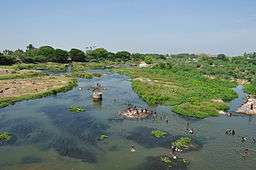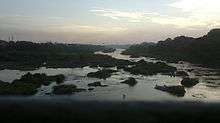Thamirabarani River
| Thamirabarani (தாமிரபரணி) | |
| River | |
 Thamirabarani River flowing across Tirunelveli | |
| Country | India |
|---|---|
| State | Tamil Nadu |
| Districts | Tirunelveli, Thoothukudi |
| Tributaries | |
| - left | Karaiyar, Servalar, Gadananathi, Chittar River |
| - right | Manimutharu, Pachaiyar |
| Cities | Tirunelveli, Ambasamudram |
| Source | Pothigai hills-பொதிகை மலைகள் |
| - coordinates | 8°36′07″N 77°15′51″E / 8.601962°N 77.264131°E |
| Mouth | |
| - location | Gulf of Mannar |
| - coordinates | 8°38′29″N 78°07′38″E / 8.641316°N 78.127298°ECoordinates: 8°38′29″N 78°07′38″E / 8.641316°N 78.127298°E |
| Length | 125 km (78 mi) |
| Discharge | for Sri Vai Kuntum |
| - average | 32 m3/s (1,130 cu ft/s) [1] |
The Thamirabarani River (Porunai) (Tamil: தாமிரபரணி(பொருனை) originates from the famous Agastyarkoodam peak of Pothigai hills of the Western Ghats, above Papanasam in the Ambasamudram taluk. It flows through Tirunelveli and Tuticorin districts of the Tamil Nadu state of southern India into the Gulf of Mannar. It was called the Tamraparni River in the pre-classical period, a name it lent to the island of Sri Lanka. The old Tamil name of the river is Porunai. From the source to sea, the river is about 125 kilometres (78 mi) long.
Etymology

From the Tamilakam era, the area of the Tamraparni river, in Tirunelveli, Tamil Nadu, has had name modifications,[2] from the original Tan Porunai river to Tamira Porunai, from Tamraparni to Tambraparni and now called "Thamirabarani River".[3][4][5] A meaning for the term following its derivation became "copper-colored leaf", from the words Thamiram (copper/red) in Tamil/Sanskrit and parani meaning leaf/tree, translating to "river of red leaves".[6][7] According to the Tambraparni Mahatmyam, an ancient account of the river from its rise to its mouth, a string of red lotus flowers from sage Agastya at Pothigai hills transformed itself into a damsel at the sight of Lord Siva, forming the river and giving it its divine name.[8] Other name derivations include the Pali term "Tambapanni", "Tamradvipa" of Sanskrit speakers and "Taprobana" of ancient Greek cartographers.[9][10][11] Robert Knox reported from his 20 years of captivity on the island in the hills that "Tombrane" is a name of the Sri Lankan Tamil people for God in Tamil, which they often repeated as they lifted up their hands and faces towards Heaven".[12]
History

Its many name derivations of Tan Porunai include Tampraparani, Tamraparni, Tamiravaruni. Tan Porunai nathi finds mention by classical Tamil poets in ancient Sangam Tamil literature Purananuru. Recognised as a holy river in Sanskrit literature Puranas, Mahabharata and Ramayana, the river was famed in the Early Pandyan Kingdom for its pearl and conch fisheries and trade.[13] The movement of people, including the faithful, trade merchants and toddy tapers from Tamraparni river to NorthWestern Sri Lanka led to the shared appellation of the name for the closely connected region. One important historical document on the river is the treatise Thamirabarani Mahathmiyam. It has many ancient temples along its banks.
In the Mahābhārata (3:88) the river is mentioned as "Listen, O son of Kunti, I shall now describe Tamraparni. In that asylum the gods had undergone penances impelled by the desire of obtaining salvation".[14]
Hydrology

Origin
The Thamirabarani River originates from the peak of the Pothigai hills on the eastern slopes of the Western Ghats at an elevation of 1,725 metres (5,659 ft) above sea-level. The river is joined by its headwater tributaries Peyar, Ullar, Pambar before it flows into the Kariyar Dam reservoir, where it meets Kariyar. The river forms the Vaanatheertham waterfalls, 40 metres (130 ft) high, as it enters the Kariyar reservoir.[15] Servalar joins the Thamirabarani before it enters into the Papanasam lower reservoir, which was built for the Papanasam Hydroelectric station.[16] The river descends down the mountains near Papanasam, where it forms the Kalyanatheertham falls and Agasthiar falls.[17][18]
Course and tributaries
The river flows on the plains eastwards from Papanasam. The first tributary to join Thamirabarani in the plains is the Manimuthar River, which originating from Manjolai hills and joins Thamirabarani near Aladiyoor village. The towns Ambasamudram and Kallidaikurichi are located respectively on the left and right banks of Thamiraparani, after which the river meets the tributary Gadananathi River at Tiruppudaimaruthur. Before the Gadananathi's entry into the Thamirabarani, the Gadananathi River is joined by the rivers Kallar, Karunaiyar and Veeranathi or Varahanathi which joins the river Gadananathi about 1.5 kilometres (0.9 mi) north-east of Kila Ambur. The Gadananathi is fed by the Jambunathi and Ramanathi Rivers. The Pachaiyar River which originates from the Kalakkadu reserve forests at about 1,300 metres (4,300 ft) above sea level joins the Thamirabarani near Tharuvai village in Palayamkottai Taluk. The river bisects the twin cities Tirunelveli and Palayamkottai before meeting its major and affluent tributary Chithar (Chitranathi) which arises in the Kutralam hills and receives supply from the rivers Gundar, Hanumanathi and Karuppanathi. The Chittar River runs almost parallel to Thamirabarani till it joins the main river near Sivalaperi. Thamirabarani passes through the taluks of Tirunelveli and Palayamkottai of Tirunelveli district and Srivaikundam and Tiruchendur taluks of Thoothukkudi district.
- List of major tributaries
| Tributaries | Length | Origin | Joins at | Length of course of Thamirabarani | Dams on the River |
|---|---|---|---|---|---|
| Karaiyar | Mundanthurai reserve forests | Karaiyar Dam | 6 kilometres (4 mi) | Karaiyar Dam | |
| Servalar River | Mundanthurai reserve forests | Papanasam Reservoir | 22 kilometres (14 mi) | ||
| Manimuthar River | 9 kilometres (6 mi) | Manjolai hills | Aladiyoor | 36 kilometres (22 mi) | Manimuthar Dam |
| Gadananathi River | Agasthyamala Biosphere Reserve | Tiruppudaimaruthur | 43 kilometres (27 mi) | Gadananathi River Dam | |
| Pachaiyar River | 32 kilometres (20 mi) | Kalakkadu reserve forests | Tharuvai | 61 kilometres (38 mi) | |
| Chittar River | 80 kilometres (50 mi) | Kutralam Hills | Sivalaperi | 73 kilometres (45 mi) | |
| Ramanathi River | Agasthyamala Biosphere Reserve | Kizha ambur | 22 kilometres (14 mi) | Ramanathi River Dam | |
Drain

The river drains into Gulf of Mannar near Punnaikayal in Tiruchendur taluk of Tuticorin district. The river drains with its tributaries an area of about 4,400 square kilometres (1,700 sq mi). As most of its extensive catchment areas lie in the Western Ghats, the river enjoys the full benefit of both the monsoons, which make the river perennial. Since all its tributaries are arising from the Western ghats, the river is prone to heavy floods especially during the northeast monsoon. In 1992, there was an unexpected flood in Thamirabarani, which claimed hundreds of lives as the dam water was let out so massively and suddenly that the river and its channels could not bear the excess water inflow. It flooded again in 2015[19] with water entering the Kurukuthurai Murugan Temple.[20]
Irrigation

The many anicuts, dams and reservoirs on the Thamirabarani river, along with those on the Manimuthar River, provide a large proportion of the water for irrigation and power generation for Tirunelveli district. It is fed by both the monsoons – the south west and the north-eastern and is seen in full spate twice a year if the monsoons do not fail. The Gadananathi River has 6 anicuts and a reservoir of 9,970,000 cubic metres (8,080 acre·ft), and irrigates 38.87 square kilometres (15.01 sq mi) of wetlands. The Ramanadhi has 7 anicuts, a reservoir of 4,300,000 cubic metres (3,500 acre·ft), and irrigates 20.23 square kilometres (7.81 sq mi) of wetlands. Pachaiyar River has 12 anicuts and irrigates 61.51 square kilometres (23.75 sq mi) of wet and dry lands.
The important irrigation channels branching off from both the banks of the river Thamirabarani are, South Kodaimelalagian channel, North Kodaimelalagian channel (Kodaimelalagian anicut), Nathiyunni channel (Nathiyunni anicut), Kannadian channel (Kannadian anicut), Kodagan channel (Ariyanayagipuram anicut), Palayam (Palavur anicut) channel, Tirunelveli channel (Suthamalli anicut), Marudur Melakkal, Marudur Keelakkal (Marudur anicut), South Main Channel and North Main Channel (Srivaikundam anicut). Of these the first seven anicuts were constructed during the period of ancient and medieval rulers and the last anicut namely the Srivaikundam anaicut was constructed and completed by the British in 1869.[21]
List of dams across Thamirabarani river:
- Kodaimelaalagain anicut, 1,281.67 hectares (3,167.1 acres)
- Nathiyunni anicut, 1,049.37 hectares (2,593.0 acres)
- Kannadian anicut, 2,266.69 hectares (5,601.1 acres)
- Ariyanayagipuram anicut, 4,767.30 hectares (11,780.3 acres)
- Palavur anicut, 3,557.26 hectares (8,790.2 acres)
- Suthamalli anicut, 2,559.69 hectares (6,325.1 acres)
- Marudur anicut, 7,175.64 hectares (17,731.4 acres)
List of channels:
- South Kodaimelalagain channel
- North Kodaimelalagain channel
- Nathiyunni channel
- Kannadian channel
- Kodagan channel
- Palayam channel
- Tirunelveli channel
- Marudur Melakkal
- Marudur Keelakal
References
- ↑ "Gauging Station - Data Summary". ORNL. Retrieved 2013-10-01.
- ↑ Leelananda Prematilleka, Sudharshan Seneviatne - 1990: Perspectives in archaeology: "The names Tambapanni and Tamra- parni are in fact the Prakrit and Sanskrit rendering of Tamil Tan porunai"
- ↑ Leelananda Prematilleka, Sudharshan Seneviatne - 1990: Perspectives in archaeology: "The names Tambapanni and Tamra- parni are in fact the Prakrit and Sanskrit rendering of Tamil Tan porunai"
- ↑ Pillai, M. S. Purnalingam (2010-11-01). Ravana The Great : King of Lanka. Sundeep Prakashan Publishing. ISBN 9788175741898.
- ↑ Caldwell, Bishop R. (1881-01-01). History of Tinnevelly. Asian Educational Services. ISBN 9788120601611.
- ↑ K. Sivasubramaniam - 2009. Fisheries in Sri Lanka: anthropological and biological aspects, Volume 1. "It is considered most probable that the name was borrowed by the Greeks, from the Tamil 'Tamraparni' for which the Pali...to Ceylon, by the Tamil immigrants from Tinnelvely district through which ran the river called to this date, Tamaravarani"
- ↑ Caldwell, Bishop R. (1881-01-01). History of Tinnevelly. Asian Educational Services. ISBN 9788120601611.
- ↑ The Indian Geographical Journal, Volume 15, 1940 p345
- ↑ K. Sivasubramaniam - 2009. Fisheries in Sri Lanka: anthropological and biological aspects, Volume 1. "It is considered most probable that the name was borrowed by the Greeks, from the Tamil 'Tamraparni' for which the Pali...to Ceylon, by the Tamil immigrants from Tinnelvely district through which ran the river called to this date, Tamaravarani"
- ↑ Leelananda Prematilleka, Sudharshan Seneviatne - 1990: Perspectives in archaeology: "The names Tambapanni and Tamra- parni are in fact the Prakrit and Sanskrit rendering of Tamil Tan porunai"
- ↑ Mendis, G.C. (2006). "The ancient period". Early History of Ceylon (Reprint ed.). Asian Educational Services. p. 33. ISBN 81-206-0209-9. Retrieved 2009-11-06
- ↑ Robert Knox. 1651. An Historical Relation of the Island Ceylon in the East-Indies. - London. p167
- ↑ "Rivers of Western Ghats - Origin of Tamiraparani". Centre for Ecological Sciences. Indian Institute of Science. Retrieved 8 March 2012.
- ↑ Mahabharata Online.
- ↑ "Ambasamudram - Tourism". ambasamudram.net. Retrieved 8 March 2012.
- ↑ "Ambasamudram - Rivers". ambasamudram.net. Retrieved 8 March 2012.
- ↑ "Rivers of Tamil Nadu". discovertamilnadu.net. Retrieved 8 March 2012.
- ↑ "Tirunelveli - Places". Tamil Nadu Tourism Development Corporation. Govt. of Tamil Nadu. Retrieved 8 March 2012.
- ↑ http://www.dailythanthi.com/News/State/2015/12/08125537/Flood-in-Thamirabarani-River-people-evacuated-from.vpf
- ↑ http://kollyzone.org/2015/11/flood-in-thamirabarani-river-devotees-banned-to-visit-kurukkuthurai-murugan-temple/
- ↑ "Tirunelveli District Irrigation". Tirunelveli District Administration. Govt. of Tamil Nadu. Retrieved 8 March 2012.
External links
| Wikimedia Commons has media related to Thamirabarani River. |